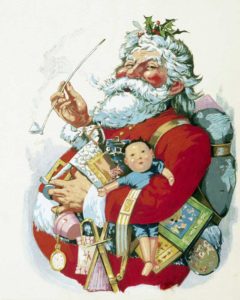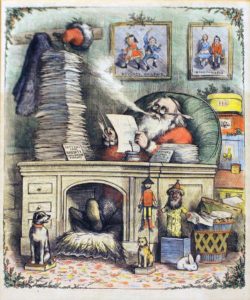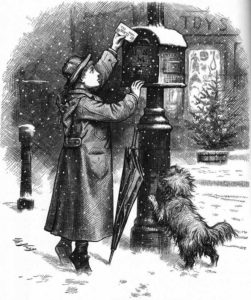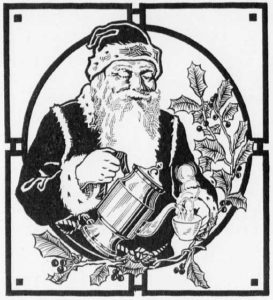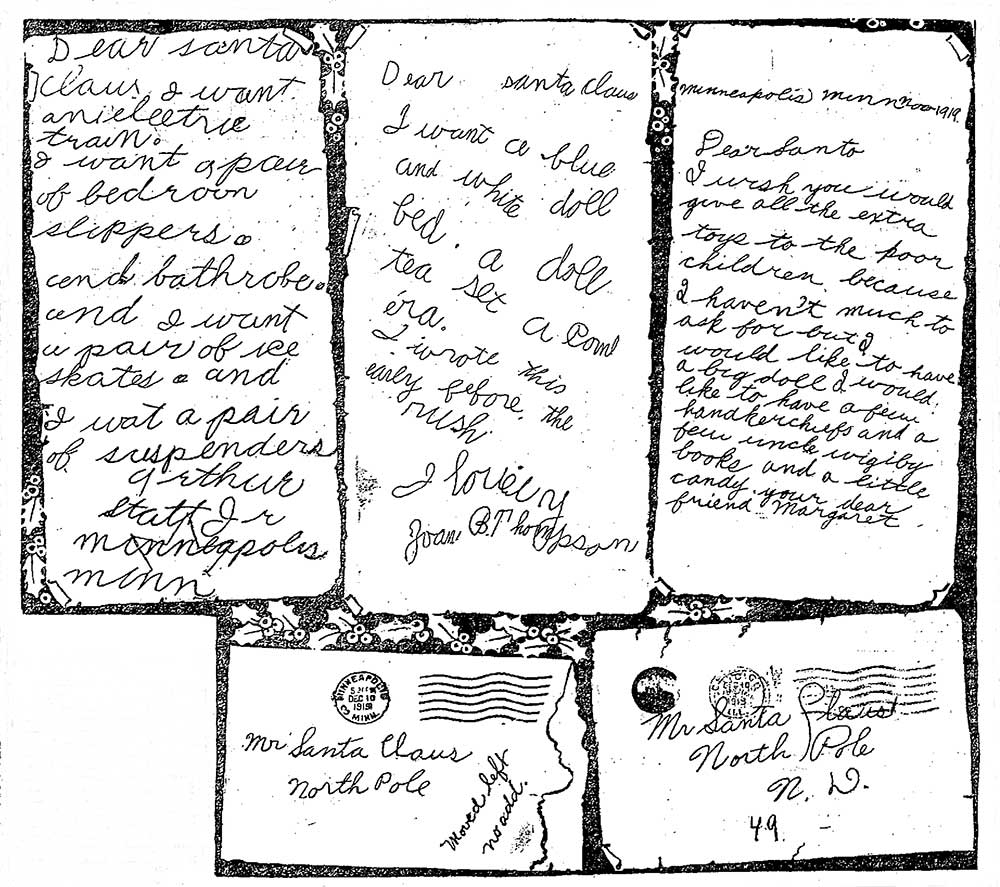Small Home Gazette, Fall 2021
The Challenge of Santa’s Mail
For many children, Santa Claus represents love and magic and hope and happiness. Writing letters to Santa is a Christmas tradition that began as early as the 1870s.
“These letters—they’re from tykes who are just learning to make big print letters…and from boys and girls of 10 and 11 years—boys and girls, sometimes, whom their baby-time Santa Claus has disappointed, but who have this year taken fresh hope that there’s a real Santa Claus, if one could only find him…” (The Minneapolis Sunday Tribune, December 21, 1919)
The challenge was “finding” Santa. How did children of the bungalow era get their letters to Santa Claus?
The Changing Image of Santa
Some of the earliest Christmas correspondence was not written TO Santa, but rather FROM him. In the first half of the 19th century, Santa was used as a disciplinary figure. Parents wrote the letters to their children, discussing their conduct over the previous year—“naughty” or “nice.”
The American image of Santa Claus developed in the 1800s, from the 1823 publication of the poem “A Visit From St. Nicholas” (known by its first line, “’Twas the night before Christmas”) to cartoonist Thomas Nast’s Christmas illustrations in the widely-read Harper’s Weekly.
In 1871, Nast created an image of Santa Claus sitting at a desk piled high with letters from the parents of naughty and nice children. His illustrations helped create the idea that Santa lived at the North Pole, wore red, and had a white beard—and a child could mail a letter to him.
In 1879, Nast’s illustration of a young person putting a letter addressed to “St. Claus North Pole” in a mailbox was the first known image of a child using the U.S. postal service to write to Santa.
The Nast illustrations created a fresh image of Santa, and the postal service soon became the recipient of children’s Christmas wishes. Not equipped for the job, letters addressed to “Santa” or The North Pole” were returned to sender, if known, or sent to the Dead Letter Office where they were burned.
“The Post Office Department does not believe in Santa Claus,” the New York Times wrote in 1906. “The Christmas season has no charm for the prosaic employees of the Dead Letter Office. It means only a lot of extra work and bother for them.” The article went on to condemn the unsympathetic post office and “red-tape-bound officialdom” for their lack of imagination to find a way to honor the children’s requests.
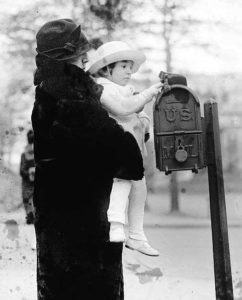 The following year, the Postmaster General changed the rules on answering letters and allowed for their distribution to interested charities and philanthropists. Complaints began—how to verify the needs of the children?? The distribution of letters was not renewed the next year.
The following year, the Postmaster General changed the rules on answering letters and allowed for their distribution to interested charities and philanthropists. Complaints began—how to verify the needs of the children?? The distribution of letters was not renewed the next year.
By 1912, Postmaster General Frank Hitchcock made it official with Operation Santa—a program authorizing local Postmasters to allow postal employees and citizens to respond to the letters. (By the 1940s, mail volume for Santa increased so much the Postal Service invited charitable organizations and corporations to participate. Today, customers can go online to browse through the letters and if one touches their heart, they can adopt it and help the child have a magical holiday.
The Role of Newspapers
Before the Post Office Department changed its rule to allow the release of Dear Santa letters, newspapers recognized the letters made for an engaging peek inside the minds of children and encouraged children to mail letters directly to them. They promised to forward them on to Santa. Publishing the letters, complete with misspellings, became an annual event by the turn of the 20th century, often with prizes for the best letters.
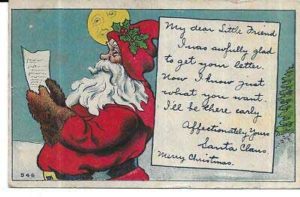
My dear Little Friend
I was awfully glad to get your letter. Now I know just what you want. I’ll be there early
Affectionately Yours
Santa Claus
Merry Christmas
Nothing is more magical than seeing the holidays through the eyes of a child. Some of the letters were sweet; some funny or sad; and some showed caring of others. Many Dear Santa letters reflected the culture and concerns of the era, but children always wanted toys, candy, fruit and nuts, and firecrackers to celebrate the holiday!
Often included were helpful hints on where to buy the presents or where to put that “bicycle that won’t fit into the stocking” or a ranking system, so that Santa would have a back-up plan. Girls were more considerate than boys, wishing something for others, and more appreciative of Santa’s hard work. There was often the fear that Santa would not find them if the family had moved, so an address (of sorts) was included.
Here are examples from the bungalow era. Spelling and grammar from the original letters have been retained.
Sweet Letters
 Dear Santa Claus: Please bring me a wagon and sled and some games and a nice book. I was a good boy sometimes, and never get my feet wet, only sometimes. Good-bye, Santa Claus. Yours for business, Harry Froembling, Main Street, in the Yellow House.
Dear Santa Claus: Please bring me a wagon and sled and some games and a nice book. I was a good boy sometimes, and never get my feet wet, only sometimes. Good-bye, Santa Claus. Yours for business, Harry Froembling, Main Street, in the Yellow House.
Fergus Country Argus (Montana), December 16, 1903
 Virginia Oliver’s long letter was printed in The Marshall Republican (Missouri), on December 17, 1909. After listing all the things she wanted for herself and siblings, she ended by writing “P.S. If anything happens and you can’t come, please send one of your boys.”
Virginia Oliver’s long letter was printed in The Marshall Republican (Missouri), on December 17, 1909. After listing all the things she wanted for herself and siblings, she ended by writing “P.S. If anything happens and you can’t come, please send one of your boys.”
 Dear Santa: I am a little boy from Belfast, Me., 11 years old. I didn’t expect to see a Santa down here. For a present I would like a basket ball. If you haven’t a basket ball anything will be acceptable. But didn’t think of seeing a Santa down here this hot weather. Be sure and bring me something if you can’t give me a basket ball. Please, Santa. (unsigned)
Dear Santa: I am a little boy from Belfast, Me., 11 years old. I didn’t expect to see a Santa down here. For a present I would like a basket ball. If you haven’t a basket ball anything will be acceptable. But didn’t think of seeing a Santa down here this hot weather. Be sure and bring me something if you can’t give me a basket ball. Please, Santa. (unsigned)
The Daytona Daily News (Florida) December 18, 1915
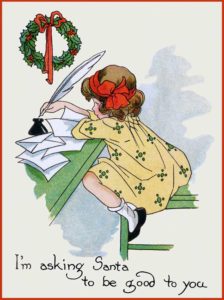 Funny Letters
Funny Letters
 Dearest Santa Claus: I thought you might forget me, so I thought I would write you a reminder. I smashed everything you sent me last year. Lynwood Kain
Dearest Santa Claus: I thought you might forget me, so I thought I would write you a reminder. I smashed everything you sent me last year. Lynwood Kain
Richmond Times-Dispatch (Virginia), December 22, 1903
 Dear Santa: I went up to Cohen’s store told you what I wanted. Now don’t forget to bring me tools for my tool chest papa made for me, and some candy and fireworks and nuts and oranges. Oh, Santa, I forgot to tell you about my little brother, he is name Graham Kelley. I wish you would bring him a rattler, and please see if you can’t bring him some teeth. I have asked the doctor, and he can’t get him any, but I hope you can. He is three months old and I am four years old. Please put my letter in the paper. Your little boy, Paul Kelley
Dear Santa: I went up to Cohen’s store told you what I wanted. Now don’t forget to bring me tools for my tool chest papa made for me, and some candy and fireworks and nuts and oranges. Oh, Santa, I forgot to tell you about my little brother, he is name Graham Kelley. I wish you would bring him a rattler, and please see if you can’t bring him some teeth. I have asked the doctor, and he can’t get him any, but I hope you can. He is three months old and I am four years old. Please put my letter in the paper. Your little boy, Paul Kelley
Richmond Times-Dispatch (Virginia) December 22, 1903
 Dear Santa Claus: I want a horse, a train of cars, a drum, and a football. I guess you can send a horn. My Grandpa burns is the policeman and I’ll tell him to not bother you on Xmas, cause he might think you was a robber going down the chimney. Good-bye, Santa Claus; from your loving little friend Orville E. Burns.
Dear Santa Claus: I want a horse, a train of cars, a drum, and a football. I guess you can send a horn. My Grandpa burns is the policeman and I’ll tell him to not bother you on Xmas, cause he might think you was a robber going down the chimney. Good-bye, Santa Claus; from your loving little friend Orville E. Burns.
Oregon City Courier (Oregon) December 18, 1908
 Dear Santa Claus: Please bring me an elephant, a sure enough elephant that can roar, some lions, a choo-choo with six cars, a wagon with two wheels and a little snake. I am three years old. Kenneth Purdy
Dear Santa Claus: Please bring me an elephant, a sure enough elephant that can roar, some lions, a choo-choo with six cars, a wagon with two wheels and a little snake. I am three years old. Kenneth Purdy
The Pensacola Journal (Florida) December 21, 1910
 Dear Santa: Please send us a new cellar. We had a cellar but papa left the corks in the home brew. (unsigned)
Dear Santa: Please send us a new cellar. We had a cellar but papa left the corks in the home brew. (unsigned)
Rochester Daily Post and Record (Minnesota) December 10, 1923
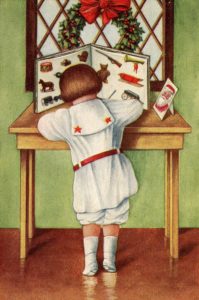 Poignant Letters
Poignant Letters
 Dear Santa Claus: I am a little girl, 7 years old, and I’m afraid that you won’t call at our house, because we are so poor. Father has to work hard all day and mother is sick and says we needn’t expect anything. Please when you are on the west side if you will just call and leave a little book or something I will be much obliged. You can’t come down the chimney, because it is too small, but I will open the door if you knock. Ada Butler
Dear Santa Claus: I am a little girl, 7 years old, and I’m afraid that you won’t call at our house, because we are so poor. Father has to work hard all day and mother is sick and says we needn’t expect anything. Please when you are on the west side if you will just call and leave a little book or something I will be much obliged. You can’t come down the chimney, because it is too small, but I will open the door if you knock. Ada Butler
Chicago Daily Tribune (Illinois) December 25, 1906
 Dear Santa Claus: I was sorry when mother told me that two of your reindeers were sick. I am hoping this is not so. If you do come around do not forget to leave a popgun, a new suit, a new sweater, new shoes, a football, helmet, nuts, candy, cakes, fruits, games, a new cap to match my suit, bicycle, pair of kid gloves, football suit and a tree. Do not forget to leave something for my sisters, brother and parents. I hope this letter will find you and Mrs. Santa Claus and all the other Clauses well. I remain, as ever, Kenton Christopher, 6 years old.
Dear Santa Claus: I was sorry when mother told me that two of your reindeers were sick. I am hoping this is not so. If you do come around do not forget to leave a popgun, a new suit, a new sweater, new shoes, a football, helmet, nuts, candy, cakes, fruits, games, a new cap to match my suit, bicycle, pair of kid gloves, football suit and a tree. Do not forget to leave something for my sisters, brother and parents. I hope this letter will find you and Mrs. Santa Claus and all the other Clauses well. I remain, as ever, Kenton Christopher, 6 years old.
Belleville New Democrat (Illinois) December 15, 1919
 Dear Santa Claws: Shortly after Christmas last year the best daddy every lived left us and went to heaven. He yoused to tell you (word crossed out here) what we wanted but this year (another word blotted out) I’ll have to send you this letter and ask you to please rimember us. My sister helen is 6 yrs old. Baby Ann is one year and a half and I am 8 yrs old. You can bring us jist what you think we should have. Id love to have a pair of skates and some dishes. Beatris
Dear Santa Claws: Shortly after Christmas last year the best daddy every lived left us and went to heaven. He yoused to tell you (word crossed out here) what we wanted but this year (another word blotted out) I’ll have to send you this letter and ask you to please rimember us. My sister helen is 6 yrs old. Baby Ann is one year and a half and I am 8 yrs old. You can bring us jist what you think we should have. Id love to have a pair of skates and some dishes. Beatris
The Minneapolis Sunday Tribune (Minneapolis) December 21, 1919
 Dear Santa Claus: I am sorry I haven’t wrote before but my pet dog got his leg broke and I thought we would hafta have him killed but he will get well. So Santa please come to Rhinelander. I and my pet dog Shep would like to see you. I haven’t any little brothers and sisters only one big brother. I am nine years old and bring me, dear old Santa, what you think is best for me. But as long as my dog will get well that is all I ask you. But would like to see you. Bye bye dear Santa, Wayne Akey.
Dear Santa Claus: I am sorry I haven’t wrote before but my pet dog got his leg broke and I thought we would hafta have him killed but he will get well. So Santa please come to Rhinelander. I and my pet dog Shep would like to see you. I haven’t any little brothers and sisters only one big brother. I am nine years old and bring me, dear old Santa, what you think is best for me. But as long as my dog will get well that is all I ask you. But would like to see you. Bye bye dear Santa, Wayne Akey.
Rhinelander Daily News (Wisconsin), 1929
Caring Letters
 Dear Santa Claus: I thought I would write and tell you what I want for Xmas. I would like to have a pair of high-top shoes, No. 10, a pair of skates and a sled, some candy and some nuts, and if you have any little trains left would like to have one. Please don’t forget my little sisters, Opal and Mildred. I guess they want something but just any old thing will do for them, it don’t make much difference what girls get. My name is Percy Merle Waggoner.
Dear Santa Claus: I thought I would write and tell you what I want for Xmas. I would like to have a pair of high-top shoes, No. 10, a pair of skates and a sled, some candy and some nuts, and if you have any little trains left would like to have one. Please don’t forget my little sisters, Opal and Mildred. I guess they want something but just any old thing will do for them, it don’t make much difference what girls get. My name is Percy Merle Waggoner.
The Clarksburg Daily Telegram (West Virginia), December 24, 1907
 Dear Santa Clause: Please bring me some nuts, candy, an apple and a french harp. Please Santa don’t forget the little boys in France for the Germans has killed their Santa Clause. That is all. Your little friend John W. Leonard.
Dear Santa Clause: Please bring me some nuts, candy, an apple and a french harp. Please Santa don’t forget the little boys in France for the Germans has killed their Santa Clause. That is all. Your little friend John W. Leonard.
The Mountainair Independent (New Mexico), December 19, 1918
 Dear Santa Claus: I hope you will come to see me and I will hang my stocking by the chimney. But I hope you won’t fall when you come down the chimney. And will you please bring me a football, but of course, you can’t put the football in the stocking but you can put it on the floor. R.B. Standard
Dear Santa Claus: I hope you will come to see me and I will hang my stocking by the chimney. But I hope you won’t fall when you come down the chimney. And will you please bring me a football, but of course, you can’t put the football in the stocking but you can put it on the floor. R.B. Standard
The Carlsbad Current (New Mexico), December 15, 1922
Santa allowed a child to give and get and also to believe. And with the help of the U.S. postal service and newspapers, these first decades of letters reached Santa, whether addressed to the North Pole, North Dakota, Iceland, Ice Street, Behind the Moon, or “the chimney.”









